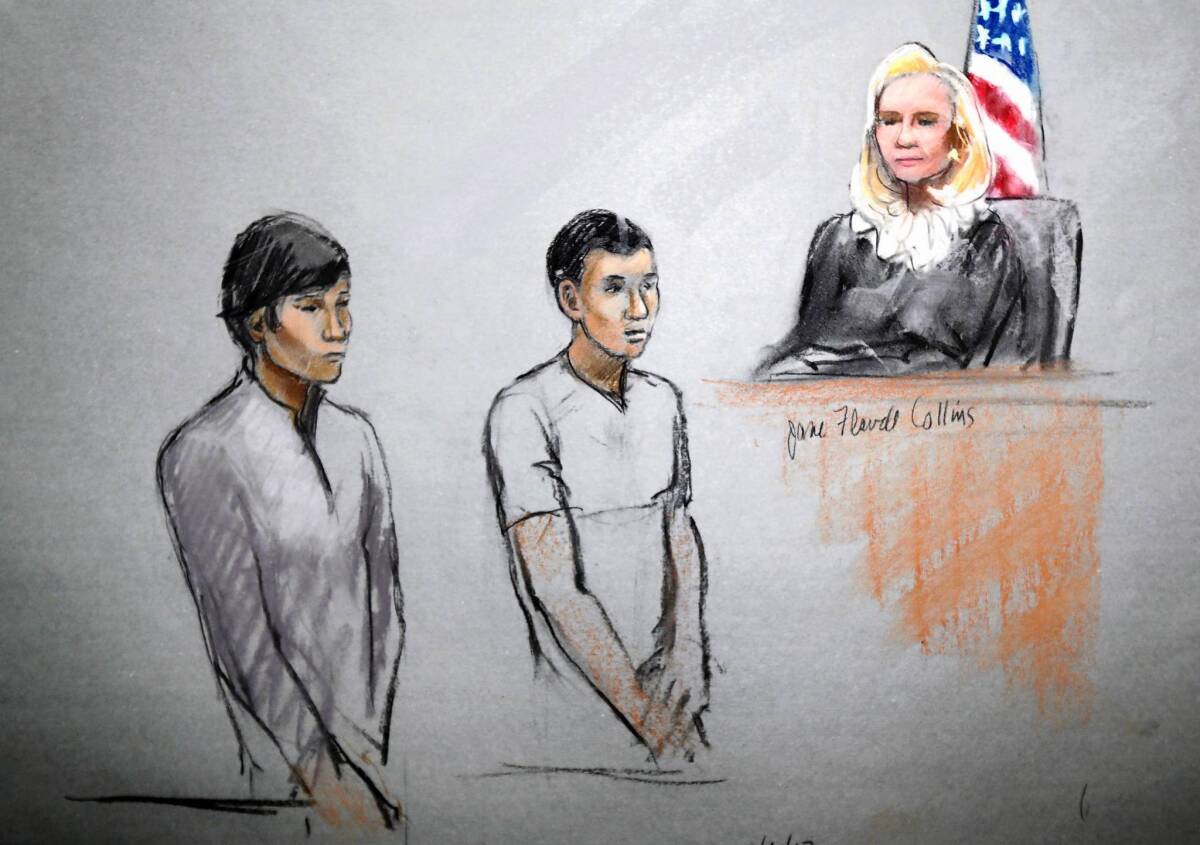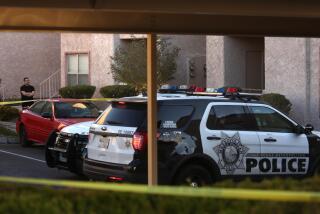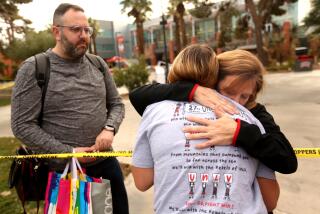Three friends of Boston bombing suspect charged

- Share via
WASHINGTON — Shortly after the FBI released photos of two Boston bombing suspects on April 18, several college friends texted Dzhokhar Tsarnaev on their cellphones. One said Tsarnaev looked like suspect No. 2, who wore a white cap backward over tufts of brown curls.
“LOL,” Tsarnaev texted back. Later, he wrote again: “Come to my room and take whatever you want.”
That night, according to an FBI complaint filed Wednesday in Boston, three young men entered Tsarnaev’s dorm room at the University of Massachusetts Dartmouth, where they all had met as students, and removed a laptop and a backpack full of fireworks that had been emptied of gunpowder. They then dumped the material in the trash, the complaint alleges.
Dias Kadyrbayev and Azamat Tazhayakov, both 19-year-olds from Kazakhstan, were charged in federal court Wednesday with conspiracy to obstruct justice. Robel Phillipos, also 19, from Cambridge, Mass., was charged with making false statements to federal law enforcement officials. Their lawyers waived bail pending a hearing on May 14.
Investigators do not believe that the three helped plan the twin bombings that killed three people and injured more than 260 others during the Boston Marathon on April 15. The two Kazakh students were arrested April 20 on suspicion of violations of immigration law, and Phillipos was taken into custody Wednesday.
Kadyrbayev’s lawyer, Robert G. Stahl, told reporters that his client “absolutely denies the charges” that he tried to obstruct the investigation. He said the sophomore engineering student did not know the items they discarded were of “any evidential value.”
Tazhayakov’s lawyer, Harlan Protass, said his client “has cooperated fully with the authorities and looks forward to the truth coming out in this case.”
Tazhayakov has been suspended from the University of Massachusetts Dartmouth pending the outcome of his case. Kadyrbayev and Phillipos are not currently enrolled, university spokesman Robert Lamontagne said in a statement. “UMass Dartmouth will continue to fully cooperate with law enforcement authorities investigating the Boston Marathon tragedy,” he said.
Tsarnaev, 19, is in custody on federal charges that he planted one of the homemade bombs that exploded along the marathon route. His brother, Tamerlan, 26, who authorities believe directed the plot, died after a shootout with police April 19.
The younger Tsarnaev met the two Kazakh students in 2011, and he soon was spending time at their off-campus apartment in nearby New Bedford. In March, he posted a picture on his Twitter feed of a vanity license plate on Kadyrbayev’s car: “Terrorista #1.”
According to the FBI complaint, Tsarnaev’s roommate let Kadyrbayev, Tazhayakov and Phillipos into the university’s Pine Dale Hall dormitory room about 6 p.m. on April 18, shortly after the FBI had asked the public to help identify two suspects captured on surveillance cameras.
Kadyrbayev saw empty boxes and husks of fireworks inside a backpack, and noted that the explosive powder had been removed, the FBI complaint said. A month before the bombings, Tsarnaev had told his friends that he knew how to build a bomb, according to the complaint.
Kadyrbayev and the two others took the fireworks remnants, a laptop computer, some of Tsarnaev’s homework papers, and a jar of Vaseline from the dorm to the apartment in New Bedford. Experts say Vaseline may have been used to seal the homemade bombs.
Phillipos later told investigators that after watching news reports that evening, the two Kazakh students “started to freak out, because it became clear from a CNN report that we were watching that Jahar [Dzhokhar Tsarnaev] was one of the Boston Marathon bombers.”
The two Kazakh friends were speaking in Russian, Phillipos recalled. At one point, about 11 p.m., Kadyrbayev asked whether he should “get rid of the stuff,” the complaint says. Phillipos replied, “Do what you have to do,” and then took a nap, he told investigators.
Kadyrbayev stuffed the backpack into a black trash bag with garbage from the apartment and put it into a dumpster outside the apartment complex, according to prosecutors. He later told investigators he wanted “to help his friend … avoid trouble,” they said.
Police ultimately recovered the bag from a landfill in New Bedford. It is unclear whether investigators have found the missing laptop.
Prosecutors alleged that when the FBI interviewed Phillipos, he concealed the fact that he went to Tsarnaev’s dormitory room and that he knew items were taken from the room.
It’s not yet clear why the FBI failed to search the dormitory room until April 21, three days after the younger Tsarnaev was identified and two days after he was wounded and captured by police. When FBI investigators did, they recovered a “large pyrotechnic” as well as the black jacket and white hat investigators believe he wore at the marathon.
The bombs would have required about one to two pounds of black powder explosives to produce the plumes of smoke seen in video of the blasts, said Dave Williams, a retired FBI special agent bomb expert. Large over-the-counter fireworks usually have about an ounce of explosives inside.
Photos released with the criminal complaint showed a large quantity of fireworks, but not enough for the two bombs, said Williams, who worked on the investigations of the 1993 World Trade Center bombing and the 1995 Oklahoma City federal building bombing.
More to Read
Sign up for Essential California
The most important California stories and recommendations in your inbox every morning.
You may occasionally receive promotional content from the Los Angeles Times.











